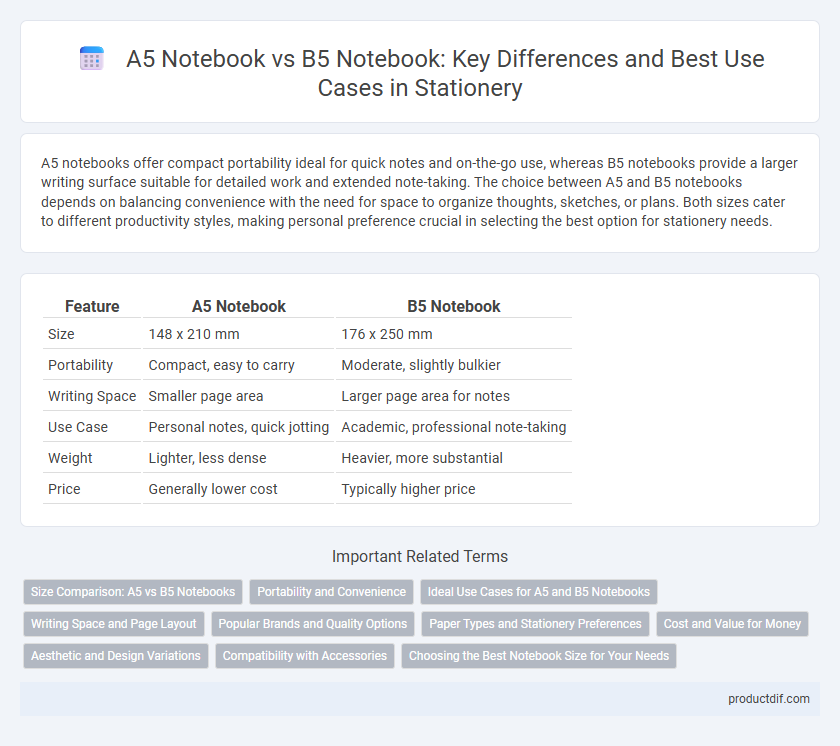A5 notebooks offer compact portability ideal for quick notes and on-the-go use, whereas B5 notebooks provide a larger writing surface suitable for detailed work and extended note-taking. The choice between A5 and B5 notebooks depends on balancing convenience with the need for space to organize thoughts, sketches, or plans. Both sizes cater to different productivity styles, making personal preference crucial in selecting the best option for stationery needs.
Table of Comparison
| Feature | A5 Notebook | B5 Notebook |
|---|---|---|
| Size | 148 x 210 mm | 176 x 250 mm |
| Portability | Compact, easy to carry | Moderate, slightly bulkier |
| Writing Space | Smaller page area | Larger page area for notes |
| Use Case | Personal notes, quick jotting | Academic, professional note-taking |
| Weight | Lighter, less dense | Heavier, more substantial |
| Price | Generally lower cost | Typically higher price |
Size Comparison: A5 vs B5 Notebooks
A5 notebooks measure 148 x 210 mm, making them compact and ideal for portable note-taking or journaling, while B5 notebooks are larger at 176 x 250 mm, offering more writing space suitable for detailed notes and sketches. The size difference impacts usability, with A5 fitting easily into bags and planners, and B5 providing more room for organized, extensive content. Choosing between A5 and B5 notebooks depends on the balance between portability and writing area preferences.
Portability and Convenience
A5 notebooks measure 148 x 210 mm, offering superior portability and ease of carrying in bags or small purses, making them ideal for on-the-go note-taking and quick sketches. B5 notebooks, at 176 x 250 mm, provide more writing space and comfort for detailed notes but are less compact and slightly heavier, impacting convenient transportation. Choosing between A5 and B5 depends on the balance between portability needs and the requirement for a larger writing area.
Ideal Use Cases for A5 and B5 Notebooks
A5 notebooks, with their compact 148 x 210 mm size, are ideal for portable note-taking, journaling, and quick sketches, making them perfect for students and professionals on the go. B5 notebooks, larger at 176 x 250 mm, provide more writing space suited for detailed notes, project planning, and academic work that requires ample room for diagrams and annotations. Choosing between A5 and B5 depends on the need for mobility versus extensive note-taking capacity.
Writing Space and Page Layout
A5 notebooks typically measure 148 x 210 mm, offering a compact writing space ideal for quick notes or portable use, while B5 notebooks, at 176 x 250 mm, provide a larger page layout that accommodates more detailed writing and drawing. The page layout in B5 notebooks usually includes wider margins and more lines per page, enhancing organization for students and professionals. In contrast, A5 notebooks favor portability over extensive writing space, making them suitable for on-the-go note-taking.
Popular Brands and Quality Options
A5 notebooks, favored for portability, are commonly produced by popular brands like Moleskine and Leuchtturm1917, known for their high-quality paper and durable covers. B5 notebooks, often preferred for academic or office use, are frequently offered by brands such as Kokuyo and Rhodia, which provide excellent paper quality and ample writing space. Both sizes feature options with premium acid-free paper, ensuring longevity and smooth writing experiences.
Paper Types and Stationery Preferences
A5 notebooks typically feature lighter paper weights ranging from 70gsm to 90gsm, making them ideal for everyday writing and portability, while B5 notebooks often use thicker paper types between 90gsm and 120gsm, preferred for sketching or detailed note-taking. Stationery enthusiasts favor A5 notebooks for their compact size and compatibility with various pen types, whereas B5 notebooks are chosen for their spacious layouts and enhanced durability, accommodating diverse writing tools like fountain pens and markers. Paper texture in A5 notebooks tends to be smoother for general use, whereas B5 notebooks offer a range of textures including acid-free and recycled options, catering to eco-conscious users and professional creatives.
Cost and Value for Money
A5 notebooks are generally more cost-effective due to their smaller size, making them ideal for budget-conscious buyers seeking portability without sacrificing usability. B5 notebooks, while slightly more expensive, offer greater writing space and durability, providing better value for professionals or students who require extensive note-taking. Comparing cost per page, B5 notebooks often yield better value for money despite the higher initial investment.
Aesthetic and Design Variations
A5 notebooks feature a compact size ideal for portability and personal journaling, often showcasing minimalist and sleek cover designs that emphasize clean lines and modern aesthetics. B5 notebooks offer a larger canvas, allowing for more intricate cover art and varied textures, appealing to users who prefer a balance between ample writing space and stylish design expression. Both formats provide diverse color palettes and binding options, but A5 notebooks tend to prioritize elegant simplicity, while B5 notebooks embrace creative detail and visual variety.
Compatibility with Accessories
A5 notebooks offer greater compatibility with standard stationery accessories such as pen holders, planners, and folders designed for compact sizes, enhancing portability and convenience. B5 notebooks, being larger, better accommodate full-sized accessories like document sleeves and expansive calendar inserts, which support detailed note-taking and organization. Selecting between A5 and B5 notebooks depends on the specific accessory needs and usage scenarios for efficient stationery integration.
Choosing the Best Notebook Size for Your Needs
Choosing between A5 and B5 notebooks depends on your specific usage and portability preferences; A5 notebooks, measuring 148 x 210 mm, offer compactness ideal for note-taking on the go, while B5 notebooks, at 176 x 250 mm, provide more writing space suitable for detailed notes or sketches. Consider the frequency of use, available storage, and writing style--A5 suits minimalists who prefer lightweight options, whereas B5 is better for those requiring additional room for annotations or layouts. Evaluating your daily activities and ergonomic comfort will help determine the optimal notebook size that balances convenience and functionality.
A5 Notebook vs B5 Notebook Infographic

 productdif.com
productdif.com